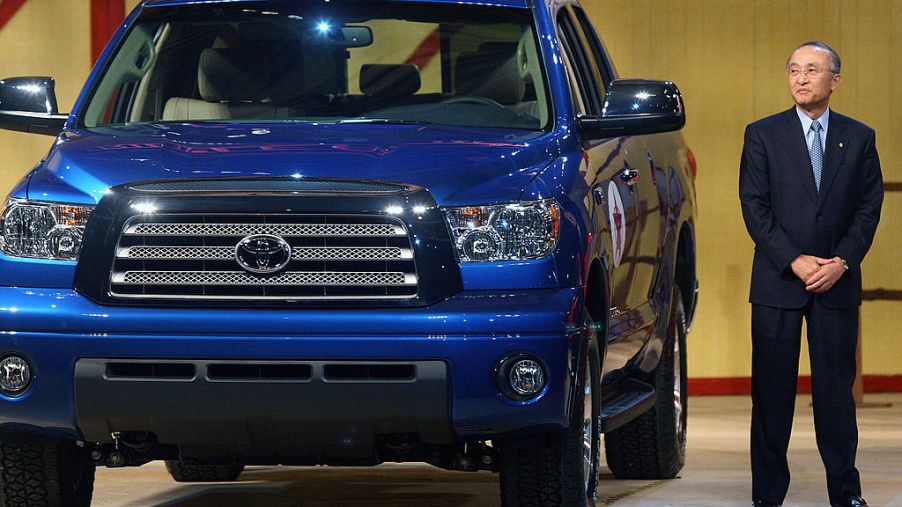
The Resilient History of the Toyota Tundra
Since its introduction in 2000, the Toyota Tundra has become an “American” classic. Although Japanese owned, its assembly and many of its components are built in the United States. That’s only one of many reasons why the Tundra maintains its top position among full-size pickup trucks.
A Toyota Tundra by any other name
While the original Tundra shared the 3.4-liter, V6 engine design with predecessor models, the Tacoma and T100, it would eventually become the Tundra’s base model. The optional 4.7, V8 was the first in its class to be introduced in Toyota truck models.
Known as the predecessor to the T100, the Tundra was originally slated as the T150. Ford took issue with the name’s similarity to their already popular F-150 pickup and filed a lawsuit. Toyota was forced to rename its new truck, and the Tundra was born.
2000 Toyota Tundra
Despite the Tundra’s larger capacity and increased production, the pickup truck was dismissed as any real competition for the established North American truck market. Still, the pickup’s sales topped any other models in Toyota history.
The 2000 Tundra garnered high praise from Consumer Reports by making their list of Best Full-Size Trucks as well as Motor Trend‘s Truck of the Year award.
2002 Toyota Tundra
Toyota made a few body style changes to the Tundra for the 2003 model year. The four-door Access Cab models offered the optional step-side bed. They also gave the grille a facelift.
Few changes were made to the relatively new Tundra. However, one notable change included the optional limited-slip differential, which was also made available to improve traction on slippery surfaces.
2003 Toyota Tundra
Using the release of the new Terminator movie to capitalize on its latest Tundra model, Toyota released a limited edition with a few upgrades.
Reminiscent of the Terminator’s black Tundra, the T3 Special edition featured a blacked-out grille and trim as well as 17-inch rims. Its cherry-red T3 badge elevated the 2003 model year to serious collectability status. Only 850 units were manufactured.
2004 Toyota Tundra
The Sequoia-inspired Tundra Double Cab was introduced in 2004. The four rear-opening doors offered more interior room and comfort. Optional stability control was also added to the updated cab design. An additional 13 inches was added to the Limited’s truck bed, allowing Toyota to compete with the larger pickup market, namely the perennial favorite, Ford.
2005 Toyota Tundra
By 2005, the Tundra’s power deficit was addressed. The result was a new 4.0L V6 engine that offered a capable 236 hp. The pickup’s towing capacity also improved to 266 lb-ft of torque.
With an upgraded VVT-I variable valve timing adjustment, Toyota’s 4.7L V8 also saw performance improvement. Its capacity was beefed up to 282 hp with 325 lb-ft of torque.
2007 Toyota Tundra
The Toyota Tundra took on the steroidal competition. The pickup’s engine was beefed up to feature a 5.7L V8 with 381 hp and 401 lb-ft of torque. Its new payload capacity was increased by 2,000 pounds, and it’s towing capacity amped out at 10,000 pounds.
Toyota added the new Crew Max cab and made adjustments to the wheelbase and bed lengths. They were out to capture the working man market. Additional safety features included electronic brake force distribution and traction control.
2009-10 Toyota Tundra
The 2009 Tundra with a 5.7L V8 engine was upgraded to an E85 fuel capability rating. The year also saw a new package added. The TRD Rock Warrior 4X4 featured 17-inch wheels and six-speed automatic transmission with manual overdrive.
The Tundra’s 2010 added a reworked 4.6L, V8 engine with six-speed automatic transmission. On the safety front, knee airbags elevated the Tundra to a five-star frontal crash test level by the NHTSA.
2014 to the present
Only a handful of changes have been made to the late model Tundras, and none of them include an engine or transmission makeover. Exterior updates involve a larger grille, new tailgate design, redesigned taillights, and enhanced front and rear fenders.
The interior saw the inclusion of a backup camera, updated ergonomics and gauges, a 3.5-inch information display screen, and Bluetooth functions.
The Tundra did offer a smoother ride with a revamped suspension, and a re-valved steering rack improved handling. The 4.0L V6 was discontinued in 2015. However, the TRD Pro was introduced, catering to off-road enthusiasts.
With new investments in the San Antonio, Texas Toyota plant totaling more than $391 million, the 2021 Tundra seems poised for a whole new era.


